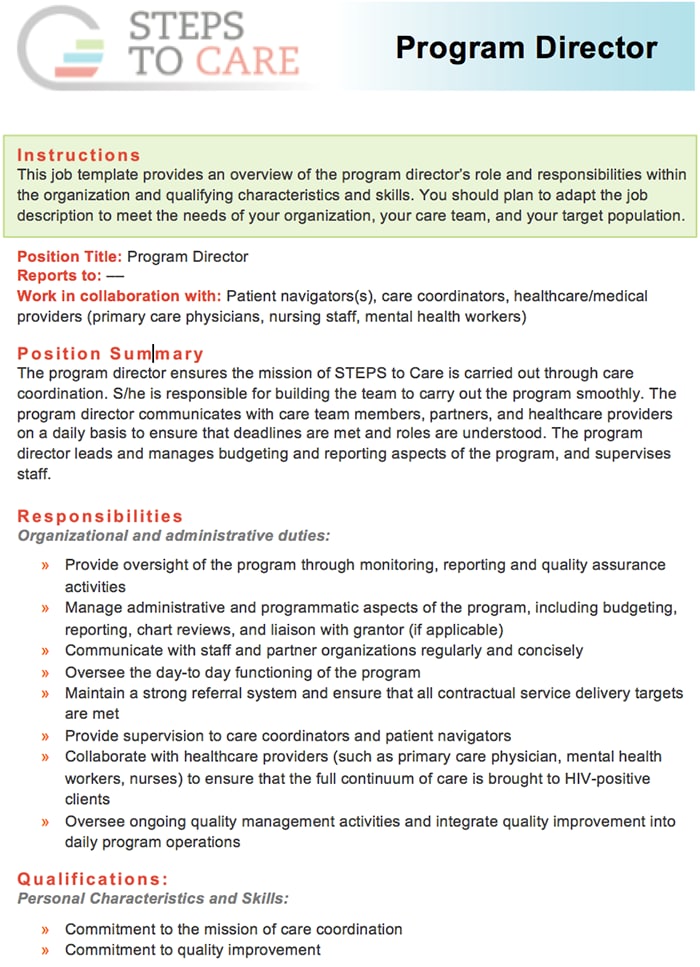STEPS to Care: Staffing and Supervision
Building your Care Team requires detailed knowledge of each role and an understanding of the qualities and experience to look for during the hiring process. Once your team is in place, the right supervision provides staff with the emotional and logistical support to deliver high-quality service.
After reviewing staffing information and resources below, you will know:
- Roles and responsibilities for each member of the Care Team
- What makes a great Program Director, Care Coordinator, and Patient Navigator
- Why finding the right staff is so important for the success of your program
- How supervisory structures can support great work and team satisfaction
Staff Roles
The roles described below should be used as a reference for staffing your program in a way that best suits your agency structure and policies. Depending on your agency needs, you may staff your program using different job titles or you may have staff with some overlapping responsibilities. You may need to make some external hires, but in most cases, STEPS staff can be drawn from existing case management or social work staff in your agency.
Key Full-Time Staff
The three primary roles that require full-time staff are Program Director, Care Coordinator, and Patient Navigator. Download the Staff Roles and Responsibilities chart [PDF – 94 KB] for general guidance on the roles and responsibilities of each member of the Care Team.

Adaptable Job Description Templates
These sample adaptable job templates are helpful tools for hiring mangers or those who wish to review responsibilities of the Patient Navigator, Care Coordinator, and Program Director with their Care Team members.
These job descriptions should be used as a starting point for creating job descriptions relevant to your agency needs. When adapting these templates, you should consider:
- The structure of your Care Team
- The needs of your target population/clients
- The supervisory needs of your team
- Existing organization staff and structures
- The administrative and funding needs of your organization
Program Director Sample Job Template [PDF – 38 KB]
Primary Care Providers
In addition to the full-time roles listed above, you will also need to select primary care providers to participate in STEPS to Care. Primary care providers give medical care to the clients participating in the program. They participate in all referral and case conference activities and keep staff apprised of important clinical events.
You may need to do some outreach to get buy-in from these providers. Additionally, program structures and practices should be crafted to maintain buy-in by increasing non-invasive communication opportunities and being respectful of other demands on the providers’ time. You should work with your providers to develop strategies that work best for your organization.
Other Service Providers
You may choose to include other roles such as mental health providers or social service providers on your Care Team. These will likely be staff with other full-time responsibilities who also serve your STEPS clients. See the Care Team Coordination page for more information on building successful structures to support the integration of these providers.
Staff Skills and Strengths Videos
In the STEPS to Care Staff Skills and Strengths videos, real Care Team members describe the skills and strengths required for Program Directors, Care Coordinators, and Patient Navigators. The videos provide guidance for finding the right staff for each role and can be used as a training resource for Care Team members to provide an overview of all Care Team roles and responsibilities.
These videos describe the following for Program Directors, Care Coordinators, and Patient Navigators:
- Key job responsibilities
- Key staff characteristics
- Key supports for care coordinators and navigators
Supervising STEPS Staff
Because of the intense nature of the program, STEPS staff benefit greatly from a process of supervision that provides both logistical (programmatic) and emotional (clinical) support. In most cases, Patient Navigators are supervised by Care Coordinators, and Care Coordinators are supervised by Program Directors.
Types of Supervision
Programmatic supervision sessions are used to review and schedule client services and identify staff and group training needs.
- Care Coordinators usually provide programmatic supervision to Patient Navigators, and Program Directors provide programmatic supervision to Care Coordinators.
- These sessions should be scheduled at the end of each week as a form of debriefing.
- Based on your agency’s staff needs, they can be conducted individually or in a group.
- Each programmatic supervision session should review Patient Navigator workloads and discuss any pressing professional challenges.
Clinical supervision sessions provide STEPS staff the opportunity to identify and discuss barriers to optimal patient engagement in care.
- Program Directors may also provide clinical supervision to Care Coordinators.
- Based on your agency’s staff needs, they can be conducted individually or in a group.
- Meetings should be scheduled at least twice a month for a minimum of one to two hours.
- These meetings also include mental health care or other service providers (e.g., substance abuse care provider).
Supervision Videos
In the Supervision videos below, real Care Team members share best practices in clinical and programmatic supervision. These videos provide guidance for establishing supervision procedures and can be used with a supervisor or supervisee to discuss supervision needs.
In the following videos, Patient Navigators, Care Coordinators, and Program Directors discuss:
- Clinical supervision: definition and importance
- Programmatic supervision: definition and importance
- Scheduling supervision sessions
- Characteristics of quality supervision



